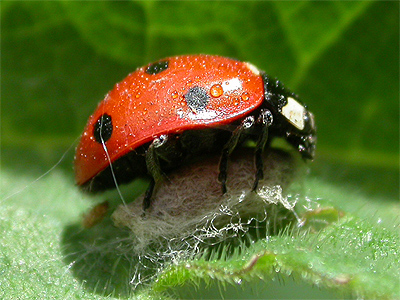| The reason is
probably down to preferred wintering habitat. During the
latter half of the year, groups of 7-spot Ladybirds can
be found clustered together on Thistles, Gorse, Brambles,
young Pines, coarse grasses and in leaf litter etc. The graph produced above shows the
highest monthly counts of both Harlequin and 7-spot
during 2011. It was only during October and November that
adult Harlequins were recorded in sufficient totals as to
show on the graph. We actually recorded no Harlequins at
all before April, which has proved to be quite typical
every year since they first arrived in Nottinghamshire.
Early November 2011 saw us
record some huge numbers of both 7-spot and Harlequin
Ladybirds at many sites, but the best numbers came on a
warm afternoon at Warsop Wood on 06/11/11, when
conservative estimates of numbers of both species were
minima of 3, 000 7-spot and 2, 000 Harlequin. The
Harlequins were particularly attracted to the light
coloured trunks of Beech trees on site (they are
attracted to bright objects and surfaces) whilst 7-spots
were found on virtually all types of vegetation at or
near ground level. The ground vegetation and leaf litter
was so full of 7-spot Ladybirds that it was never
possible to find a square metre of ground that didn't
have some 7-spots within it. Despite the huge numbers, it
was still surprising when we rolled over a large section
of felled Beech trunk and found a large number of
Harlequins clustered in two groups.
|
| This was the
first time that we had recorded such a large aggregation
of adult Harlequins. When checked again a week later,
when their numbers had swelled to approximately 264
adults. Away from urban locations, the more usual
over-wintering site for adult Harlequins that we have
noted in previous years, has been under loose bark and
occasionally tucked into the unopened growth buds of
small Pines. When under loose bark, we have found them
associating with 2-spot Ladybirds, which share similar
over-wintering preferences. On Pines, they will mix with
7-spot Ladybirds. The
Harlequin Ladybird - a threat to our native species?
We have written many times
about this recent addition to Nottinghamshire's fauna,
yet still the mere mention of the Harlequin Ladybird on
TV, radio and in the press, coincides with gloomy
predictions on it's potential affects to other
invertebrates. This now familiar Ladybird has been in the
UK since 2004 and Nottinghamshire since 2006, yet from
our own records, there is still no evidence to show that
the forcasted potential demise of an estimated 1, 800
species of invertebrates, will be directly linked to the
Harlequin's appearance or is still any nearer. Of the two
species, we have always found the 7-spot to be the more
aggressive (try moving a finger towards one on a hot day)
and it seems to have been forgotten, that many 7-spot
Ladybirds actually bit people during the big 'invasion'
year of 1976.
One of the early concerns
was that our resident Ladybirds would be most affected,
but there is still no sign from our records of any real
decrease in numbers that can be directly attributed to
the Harlequin. If any of our resident species are to be
affected, the most likely will be 2-spot, 10-spot,
Kidney-spot and Orange Ladybirds as these are often found
on the same trees favoured by the Harlequin. We have yet
to see Harlequins in any numbers on Pine sp, so
Cream-streaked, Striped and Eyed Ladybirds are unlikely
to decline.
|


